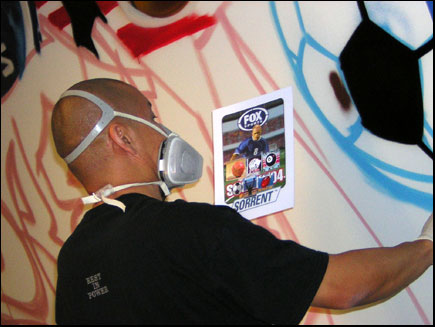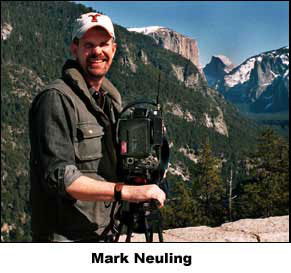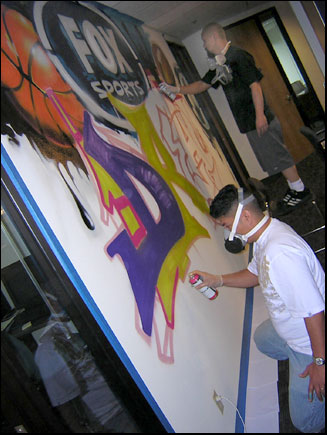LESSONS LEARNED
By Mark Neuling
Videographer
There are slow news days, but this had been a slow news week. With
our bureau chief and sole correspondent on vacation, our bureau
had become an island unto itself almost forgotten by the network
back east. We’d had two or three guests come in for satellite
interviews, but the bulk of the week had been spent on studio
chores and updating our tape library. By the time Friday rolled
around everyone was ready for the next to week to commence when
things would return to some semblance of normalcy.
Our producer, who sits right next to me, handed me the phone
and said it was Becky. Even people who’ve only met Becky Worley
once feel as though they know her. Since leaving TechTV Becky has
been freelancing. Mostly talent work as opposed to the reporting
she did at TechTV. She has shot a four-part pilot for National
Geographic Television and has kept busy with some other work unrelated
to broadcast news. Though we hadn’t spoken in months we didn’t
spend much time on small talk. A friend of hers, a producer for
a video game-maker in Los Angeles, had a sudden shoot come up in
the Bay Area for Saturday. Could I get gear and would I be available?
Oh, and they didn’t have much of a budget to work with.
In this business who you know can be more important than what you
know. Many years ago I taught video production for a few quarters
at Santa Clara University. The students at Santa Clara are intelligent,
hard working and exceptionally motivated. They could never accept
the fact that good grades, internships and a killer resume weren’t
all they would need to land that first job at a big station with
a great salary. This is a business about contacts, you still have
to deliver the goods, but who you know can help.
But back to our story. I called Becky’s friend, but this
wasn’t his project. He passed me off to the producer who
was actually responsible for the shoot. They needed to hire a “director
of photography.” The game company would be releasing a video
game shortly, portraying graffiti artists in action, and it just
so happened that a couple of graffiti artists were going to be
painting some murals at an office in the Bay Area. Of course the
first thing the producer asks me was what tape format I’d
be shooting on and what my day rates were. I quoted him a half-day
rate that was just under the number for their budget. Hesitantly,
he asked what my full-day rate was. Since I would be working sans
a sound-man and had no need for a production assistant I quoted
him a rate that was several hundred dollars over their budget,
but far less than what cameramen with a full set of gear can get
for a full day of work.
The producer needed some time to mull over the numbers. He told
me that the footage could end up being used in an actual video
game, or in a “behind the scenes” DVD in conjunction
with a game. I’d even speculate to say that some of the footage
would be included in what we call a VNR, or video news release.
Handout footage passed out to media outlets during the press blitz
that accompanies the release of a new product, in this case a video
game about graffiti artists. For a moment I thought of all the
money a still photographer might make off a project like this what
with the various copyright and licensing fees involved. But television
has, for the most part, been an industry where photographers sell
all their rights to the client. Once the shoot is over that’s
it, we hand the tape off and move on to the next project. I quip
to the producer that I should be charging them more for all the
use they’ll get from this tape.
He then asks me if there is a place on the web where they can see
some examples of my work. His art-director needs to OK this before
they will hire me. This is a first.
If you search the web you’ll find thousands of photographers
with websites. I know some television shooters who are using the
tool of a website to showcase their talents, but it’s still
rare. I for one, being for the most part a staff-photographer have
no need or desire for one. Once again Becky Worley rescues me.
Several of the reporters from my TechTV days have created their
own websites. Why not, it’s a lot cheaper than mailing out
dozens of resume tapes to news directors who’ll never look
at them. Becky’s website is by far the best. I refer the
producer to her site and explain that while I didn’t shoot
all the footage there, I did shoot a lot of it. With that I wait
for him to call me back.
The hours pass. It’s kind of like being in the position of
asking someone out for a date. Will they say yes? I can use the
extra money. We’ve just moved and there are lots of new expenses.
After four or five hours my cell phone rings. They want to book
me. I’ll get all the information about the shoot in an e-mail
they’ll be sending me. The e-mail has the location, contact
person and his phone number as well as a W-9 for taxes. There are
also some questions for our subjects and instructions for invoicing
the client. About the only thing we do discuss on the phone is
how they want the project shot. Being that this is for a video
game they want it done in the swish pan/snap zoom MTV style. Very
different than the staid network news I normally do.
The next morning I load my gear into our van and drive to my destination.
Two minutes later I pull into the parking lot of the business where
the shoot will happen. It just so happens that the shoot is located
directly across the street from my house. I can go home for fresh
coffee if I want to. I’ve been instructed that my contact
person will be inside and can let me in to the locked edifice.
I unload all my gear and haul it to the front door of the office
building.
 |
“ Frame,” my
contact and one of the graffiti artists sounds kind of
sleepy when he answers the phone. It turns out that he
is still in his hotel room. He’s waiting for his
buddy “Vogue” to arrive with their paints and
materials. Once Vogue arrives they want to get some breakfast.
Do I know of any restaurants nearby where they can get
pancakes? My recommendation for the local Denny’s
doesn’t go over very well. They’re going to
be running about an hour late he estimates; I can join
them for breakfast if I’d like. Since I’m so
close to home I politely decline and head back for that
second cup of coffee. I drop fifty cents for a paper at
the local bagel shop and wait for them to call. |
One thing about television
is that it is a medium where the standard is hurry up and wait.
And I’m still getting paid whether
I’m waiting at a courthouse, corporate boardroom or for
a pair of graffiti artists. There is no reason to sweat this
stuff;
you’ve got to just learn to be patient and wait it out.
I have my gear loaded and ready to go when the cell phone rings,
we’re only getting started two hours behind schedule.
Frame and Vogue pull up in a small pearl white Honda that’s
been lowered and in need of a little bodywork. In the back seat
is a milk carton full of spray paint cans. Vogue sits behind the
wheel. He has a long, wispy goatee with a knit cap pulled down
almost to his eyes. It feels as if he’s scrutinizing me closely,
sizing me up. Frame has a completely opposite demeanor. Friendly,
boisterous, dressed in a t-shirt and jeans with close-cropped hair
and a trim moustache. He’s in his middle thirties and has
developed a slight paunch. These two guys with a dozen cans of
spray pain in the backseat of their car would be ripe targets
for the local police. Frame is anxious to get started. In they
go with
their milk carton of paints and me with my cart of television
gear.
Things progress slowly. They don’t have any masking tape
so the administrative assistant from the company we’re shooting
at goes out to get some. Her primary job is to baby-sit us, but
later in the day I will enlist her to do the interview for me that
the producer from Los Angeles wants with our two friends. It turns
out that she had interned with one of the local television stations
but has decided against a career in television. Too bad, she did
an excellent job of the interview. Even prepared questions can
be asked in a way so that they don’t sound read. I go about
setting up lights and my tripod, but they still need more equipment,
fans for ventilation as the fumes from the paint are rather potent.
I make my second run home of the morning to fetch a pair of fans
from the basement. It’s my contribution to the success
of the shoot.
All told I will spend about six hours with Frame and Vogue. In
television we never have the luxury of spending qualitative time
with our subjects. Normally it’s get the interview, shoot
some b-roll and out. I can’t fathom the number of shoots
I’ve had over the years that were completed in under an hour.
By spending this much time with my subjects I’m getting to
know them rather well. In time they’ve forgotten that I’m
there with a rather large camera planted on my shoulder. They
are not the kind of men I had anticipated.
Both are on the downward slope to forty. Both had childhoods that
lacked a strong central male influence. Both have spray-painted
their share of graffiti murals. Both managed to avoid any serious
incidents with the police; and both have made something out of
their lives.
The
men work in tandem. Frame sketches out the general outline
of each mural and Vogue concentrates on the corporate logos
and finer details for each painting.
|
|
 |
Vogue, an Asian-American,
is the younger of the two. Once his knit cap is removed he
reveals a shaved head, giving him an even more menacing air.
But he is the more contemplative of the two – from
time to time he stands back, quietly pausing to study and
judge his work. He’s recently purchased his first home
in the East Bay. He’s studied art and is now a graphic
artist. The murals he paints now are commissioned works only.
Graffiti art is just a hobby he pursues. |
| Frame from time
to time still goes “bombing” at night as he calls
it. The oldest of four children he was raised by a single
Hispanic mother. There were times as a child that he had
to steal food in order that his family was fed. Frame has
been married for nearly a decade to a woman he’s known
for over twenty years. He and his wife have two young children.
They have built a successful financial planning service catering
to people like Frame who come from difficult financial situations.
Frame likes to talk, and talk and talk. He’s a sound
bite-a-minute machine; this would be a terrific nat-sound
story if it were for news. But not a lot of painting is getting
done and I’m not getting much footage shot. |
|
He touches on a variety
of topics, religion, politics, finances, the future of America,
immigration, and the media. Surprisingly
he sounds almost like a “Republican” on many
subjects. I stand there like a dummy with my camera turned
off politely
listening. Everyone working at the office that day gets a
sales pitch from
him for financial planning. The work on the murals proceeds
leisurely.
Later in the afternoon when it’s time for the interviews
both men give insightful and thoughtful comments, the kind that
even few corporate CEO’s
or financial analysts can give. All too soon my time with these two interesting
men is over.
I leave with a sense that America is still a land of opportunity.
© Mark
Neuling 2005
All photos and story ”Mark
Neuling 2005
All opinions expressed are solely
those of the author.
Email address is now – theneulings@Juno.com





